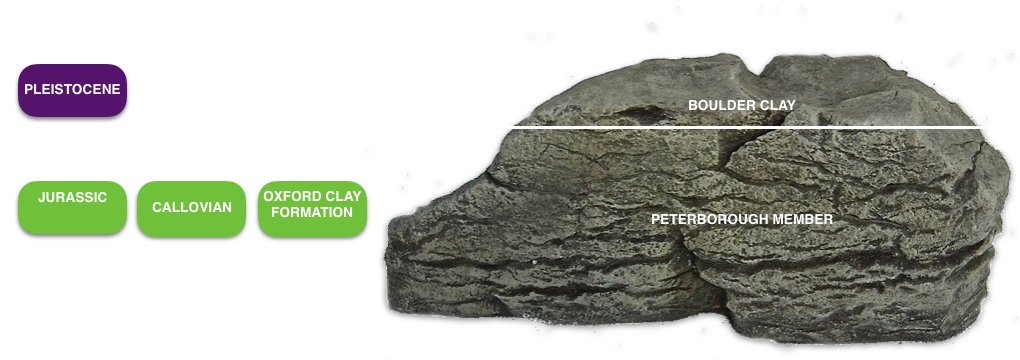Grafham Water was formally a shallow valley, now turned into a large lake, with water sports and a nature reserve. Today, plentiful fossils can be found along the banks of the lake and, during summer months when the water level is at its lowest, ammonites, belemnites and much, much more can be collected.
DIRECTIONS
♦ From the A1, take the A14 west for approximately 6.5 to 8km. Then take the exit for Grafham and follow the signs for Grafham Water. After about 5km, you will see a cycle shop and car park on your right, where you can park.
♦ Go to the foreshore and proceed to your right onto the beach.
♦ This is a SSSI, but this mainly relates to wetland birds (which are well worth looking at). Therefore, permission to search the shoreline should be sought from The Wildlife Trust and Anglian Water (by telephone). However, it is unlikely that you will be refused so long as you call.
♦ Ref: 52.29168, -0.31933
♦ Grid: TL 14724 67280
♦ Nearest Postcode: PE28 0DX
PROFILE INFO
FIND FREQUENCY: ♦♦♦ – This location is highly productive. The best time to collect is during the summer, when water levels are at their lowest.
CHILDREN: ♦♦♦♦ – If you get bored of fossil hunting, this site is excellent for the family, as there are several nature trails that can be hiked or cycled, if you rent a bike from the cycle shop. This site also has a playground, so bring a picnic. Although this location is suitable for families and children, we highly recommend that children are supervised at all times, as this is a large body of water.
ACCESS: ♦♦♦♦ – This location is very easy to access and has a good car park. There are lots of things to do and see in the area, including walks and a picnic area.
TYPE: – This lake was once a large valley, now turned into a nature reserve, with water sports on the reservoir. Fossils can be found on the banks, especially during the summer, when water is lowest.
FOSSIL HUNTING
Keep on the lookout for ammonites in the exposed Oxford Clay and do not forget to check out the banks of Boulder Clay. However, some of the most fossiliferous rock will only be exposed when the water levels are low.
At Grafham Water, ammonites and belemnites are by far the most common finds, but a wide range of shells can also be found, along with crinoid stems and Gryphaea. If you are very lucky, you can find reptile or fish remains. In addition, crocodile remains can also be found.
The best time to look is when the water level is at its lowest. Search the foreshore and banks and you will see Oxford Clay. Fossils are also revealed after downpours of rain, during summer months. Collecting has been poor at this site during years with above average rainfall, but very good in the months following drought. Keep an eye on water restrictions – if you hear of local ‘hose pipe bans’, then head in Grafham Water’s direction.

GEOLOGY
At Grafham Water, the Pleistocene Boulder Clay overlies the Oxford Clay Formation. The Boulder clay formed out of the ground moraine material of ice-sheets wherever they are found. It was the typical deposit of the Glacial Period but it is in the Oxford Clay where most of the fossils are found – this clay is extremely rich in fossils.
This has been reclassified and now falls within the Peterborough Member, being of Upper Jurassic (Callovian) age. It consists of mainly brownish-grey, fissile, organic-rich (bituminous) mudstones, with a shelly fauna dominated by crushed aragonitic ammonites and bivalves. There are also subordinate beds of pale-medium grey, blocky mudstone, with several bands of cement stone nodules/concretions. The basal beds are commonly silty, with shell beds rich in the bivalve, Gryphaea.

SAFETY
This location is a reservoir and wherever there is water, there is risk. Common sense should be used when visiting.
EQUIPMENT
Grafham Water is a bit of an unpredictable location. Sometimes you can come away with nothing and, at other times, buckets full. Much depends on beach conditions. However, you don’t need any tools to collect fossils from this site.
ACCESS RIGHTS
There are restrictions on collecting. This is a SSSI, but this mainly relates to wetland birds (which are well worth looking at). Therefore, permission to search the shoreline should be sought from The Wildlife Trust and Anglian Water (by telephone). However, it is unlikely that you will be refused so long as you call.
It is important to follow our ‘Code of Conduct’ when collecting fossils or visiting any site. Please also read our ‘Terms and Conditions‘
LINKS
♦ Buy Fossils, Crystals, Tools
♦ Location Discussions
♦ Deposits Magazine
♦ Join Fossil Hunts
♦ UK Fossils Network






